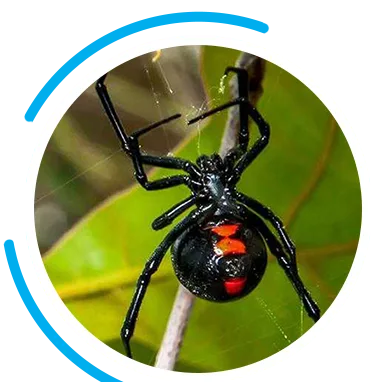Think You've Got Spiders?
We’ll get them out - Guaranteed.
Schedule your FREE inspection today!

What are Spiders?

Physical Characteristics:
Spiders have several physical features that distinguish them from other arthropods:
Eight Legs: All spiders have eight legs, which they use for walking, climbing, and capturing prey.
Two Body Segments: Spiders have a cephalothorax (head and thorax) and an abdomen, connected by a narrow waist called the pedicel.
Multiple Eyes: Most spiders have multiple eyes arranged in various patterns, with some species having as many as eight eyes.
Silk Production: Spiders have specialized silk-producing glands called spinnerets, located at the rear of their abdomen. They use silk to build webs for trapping prey, construct shelters, and produce egg sacs.
Habitat:
Spiders can be found in a wide range of habitats, including:
Forests: Many spider species inhabit forests and woodlands, where they build webs among vegetation, trees, and leaf litter.
Grasslands: Spiders are common in grasslands and meadows, where they hunt for prey on the ground and among grass stems.
Deserts: Some spider species are adapted to desert environments, where they burrow into sandy soil or seek shelter in rocks and crevices.
Urban Areas: Spiders are also found in urban environments such as homes, gardens, and parks, where they prey on insects attracted to artificial lights and structures.
Behavior:
Spiders exhibit a wide range of behaviors that are characteristic of the order Araneae:
Web Building: Many spiders are skilled web builders, constructing intricate webs to capture flying insects or create shelters for resting and mating.
Hunting: Some spiders are active hunters that rely on stealth and agility to capture prey, stalking or ambushing insects on the ground or in vegetation.
Venomous Predators: Spiders use venom to immobilize and digest their prey, injecting venom through specialized fangs called chelicerae.
Reproduction: Spiders reproduce sexually, with males using elaborate courtship displays to attract mates. Females typically lay eggs in silk egg sacs, which they guard until the eggs hatch into spiderlings.
Ecological Importance:
Spiders play important roles in ecosystems as:
Predators: Spiders are voracious predators of insects and other arthropods, helping to regulate populations of pest species and maintain ecological balance.
Prey: Spiders are also prey for a variety of animals, including birds, reptiles, amphibians, and other spiders.
Silk Producers: Spiders produce silk, a strong and elastic protein fiber that has a wide range of ecological functions, including prey capture, shelter construction, and dispersal of spiderlings.
Interactions with Humans:
While spiders are generally beneficial animals, they can sometimes come into conflict with humans:
Venomous Species: Some spider species possess venom that can cause painful bites in humans, although most spider bites are relatively harmless and only cause mild symptoms such as redness, swelling, and itching.
Fear and Phobias: Arachnophobia, or the fear of spiders, is a common phobia that affects many people worldwide. However, most spiders are harmless and pose no threat to humans.
Control and Management:
Controlling spider populations and managing interactions with humans often involves:
Sanitation: Keeping indoor and outdoor areas clean and free of clutter can help reduce spider habitats and hiding places.
Sealing Entry Points: Sealing cracks, gaps, and openings in buildings can prevent spiders from entering indoor spaces.
Integrated Pest Management: Implementing integrated pest management (IPM) strategies, such as reducing insect populations and using targeted insecticides, can help control spider populations indirectly by reducing their prey.
















